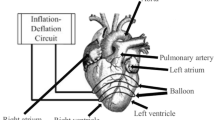Abstract
A drive control method with direct cardiac potential trigger for a ventricular assist device (VAD) was evaluated in various conditions in an experimental model. A pneumatic VAD was implanted as a support bypass between the left ventricular apex and the ascending aorta in eight animals. The hemodynamic parameters and pump output were monitored. Two tips of a bipolar electrode were set on the RV (n=3) or on the RV and LV (n=5) for recording direct cardiac potential. The counter-pulsation drive of the VAD was applied by using the R wave in the standard electrocardiogram (ECG) or the direct cardiac potential as an ECG trigger. As special conditions with various artifacts on the ECG, electromusculogram, arrhythmia, irregular ventilation, and passive vibration (simulation of exercise) were set for assessing the ECG trigger modes. Artifacts of irregular ventilation and passive vibration made the drive control poor under standard ECG trigger and caused incomplete control in the case of direct cardiac potential trigger by using the RV bipolar electrode. In contrast, direct cardiac potential trigger by using the RV and LV bipolar electrode maintained the counter-pulsation control of the VAD well in all conditions of this study. The results suggest that this counter-pulsation control with direct cardiac potential trigger might be one of the control methods for various VADs of the next generation.
Similar content being viewed by others
References
Kitamura M, Kawai A, Hachida M, Nishida H, Endo M, Koyanagi H. Clinical experience of left ventricular assist systems at The Heart Institute of Japan. Artif Organs 1999;23:286–289
McCarthy PM, Portner PM, Tobler HG, Starnes VA, Ramasamy N, Oyer PE. Clinical experience with the Novacor ventricular assist system: bridge to transplantation and the transposition to permanent application. J Thorac Cardiovasc Surg 1991;102:578–587
Poirier V, Dasse K. Clinical results of the Heart Mate implantable blood pump. In: Unger F (ed) Assisted circulation 4. Berlin: Springer-Verlag, 1995;76–86
Farrar DJ. Preoperative predictors of survival in patients with Thoratec ventricular assist devices as a bridge to heart transplantation. Thoratec ventricular assist device principal investigators. J Heart Lung Transplant 1994;13:93–101
Nakatani T, Anai H, Eya K, Wakisaka Y, Toda K, Taenaka Y, Tatsumi E, Masuzawa T, Baba Y, Takano H. Development and in vivo evaluation of an implantable left ventricular assist system with an impedance based monitoring and control system. ASAIO J 1995;41:M324-M327
Arai H, Fujiyoshi K, Sakamoto T, Suzuki A, Swartz MT. Optimal control algorithm for pneumatic ventricular assist devices: its application to automatic control and monitoring of ventricular assist device. Artif Organs 1996;20:1034–1041
Kitamura M, Morishita A, Kodera K, Endo M, Hashimoto A, Koyanagi H. In vivo assessment of optical fiber photoelectric switch system for implantable ventricular assist device. ASAIO J 1995;41:34
Muller J, Wallukat G, Weng YG, Dandel M, Spiegelsberger S, Semrau S, Brandes K, Theodoridis V, Loebe M, Meyer R, Hetzer R. Weaning from mechanical cardiac support in patients with idiopathic dilated cardiomyopathy. Circulation 1997;96:542–549
Kitamura M, Akimoto T, Koyanagi H, Tagusari O, Niinami H, Yamazaki K, Endo M, Hashimoto A. Trans-mitral ventricular uptake for temporary left ventricular support without blood stagnation. In: Akutsu T, Koyanagi H (eds) Artificial heart IV. Tokyo: Springer-Verlag, 1993;339–341
Vetter HO, Kaulbach HG, Haller M, Hummel T, Schmitz C, Dwvald O, Brenner P, Kreuzer E, Uberfuhr P, Reichart B. Use of the Novacor left ventricular assist system as a bridge to cardiac transplantation: first experience with long-term patients on the wearable system. In: Unger F (ed) Assisted circulation 4. Berlin: Springer-Verlag, 1995;65–75
Loebe M, Weng Y, Muller J, Dandel M, Halfmann R, Spiegelsberger S, Hetzer R. Successful mechanical circulatory support for more than two years with a left ventricular assist device in a patient with dilated cardiomyopathy. J Heart Lung Transplant 1997;16:1176–1179
DeRose JJ, Argenziano M, Sun BC, Reemtsma K, Oz MC, Rose EA. Implantable left ventricular assist devices: an evolving long-term cardiac replacement therapy. Ann Surg 1997;226:461–468
Author information
Authors and Affiliations
Corresponding author
Rights and permissions
About this article
Cite this article
Kitamura, M., Morishita, A., Konuma, T. et al. Reliable trigger of direct cardiac potential for stable drive control of ventricular assist device. J Artif Organs 3, 91–95 (2000). https://doi.org/10.1007/BF02479971
Received:
Accepted:
Issue Date:
DOI: https://doi.org/10.1007/BF02479971




